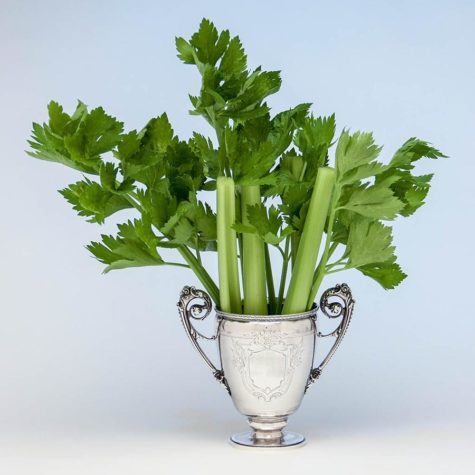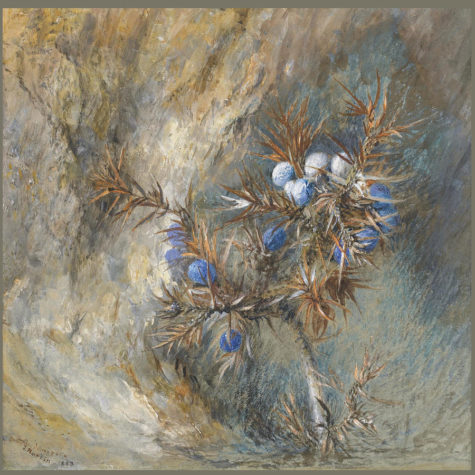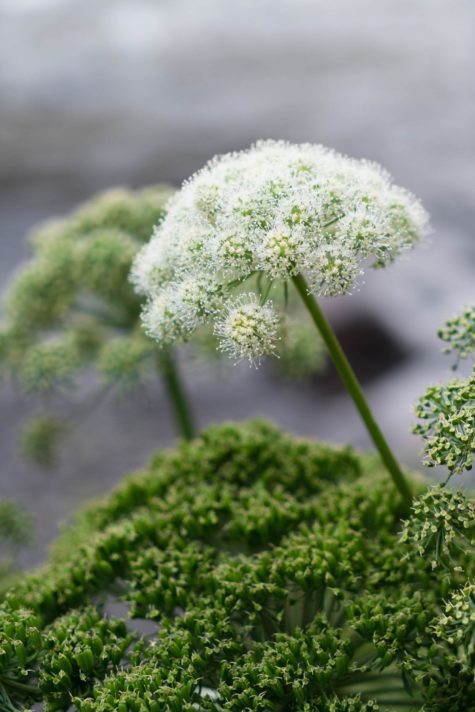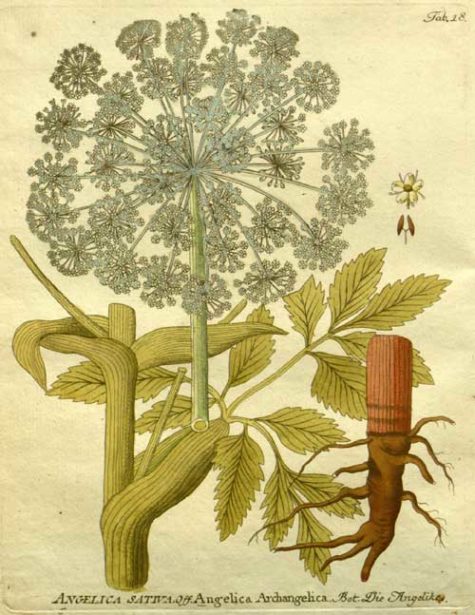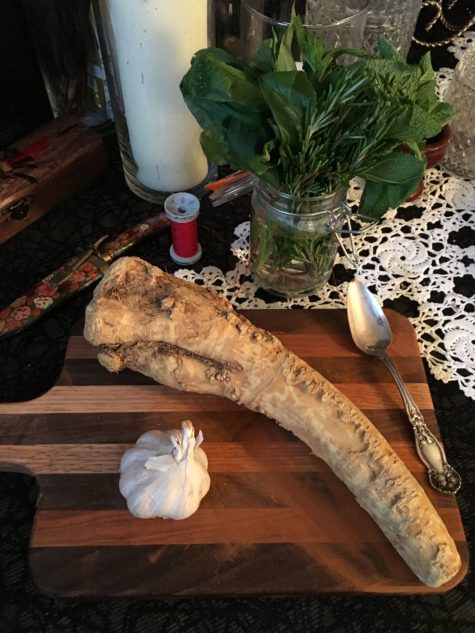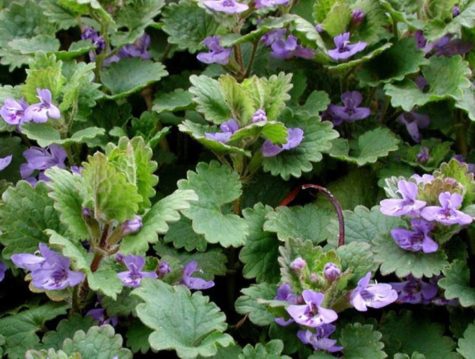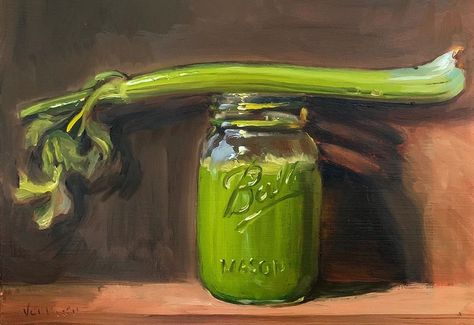
Magickal Uses
- Ruler: Mercury
- Element: Air
- Parts Used: Seed, Stalks, Oil
- Magickal Influences: Psychic awareness, Sleep
It should be mentioned that this is the garden celery under the rulership of Mercury, rather than Wild Celery, which is under the dominion of Venus.
This herbal seed, found in most kitchens, is used as a Visionary Herb. There are forms of divination which recommend drinking a tea of the seed as it opens the mind and allows for better concentration.
Use celery seed to increase male virility. Men can either eat it or add it to poppets in sympathetic magick spells.
To awaken your psychic awareness, crush about a teaspoon of the dried seeds and tie up in a piece of thin, cotton cloth. Inhale the odor and visualize your conscious mind relaxing (perhaps as a fist relaxes), allowing true communication with your psychic mind to occur.
- Rub the oil into fingers or the third eye to increase communication skills.
- Eat raw celery to remove blocks and fears and to promote weight loss.
- Cook the stalks in soup for love.
Folklore recommends putting celery into an herb pillow to induce sleep. Chewing celery seeds reportedly enhances concentration. Or burn them with orris root (iris roots) to enhance psychic powers. Witches flying on their brooms chewed celery seed to prevent dizziness.
Celery is sometimes used as a cure for impotence. Several sticks of celery need to be boiled in a saucepan of water until the celery turns into a pulp. The person with the problem needs to eat this while it is still hot, and can then look forward to a night of successful lovemaking.
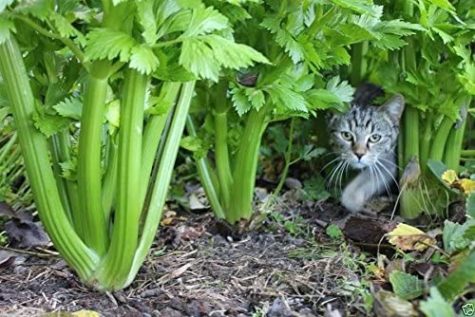
Folk and Other Names
- Aches des Marais
- Ajmoda
- Ajwan
- Apii Frutus
- Apio
- Céleri
- Celeriac
- Fruit de Celeri
- Graine de Céleri
- Karmauli
- Maiden’s Smallage
- Persil des Marais
- Qin Cai
- Smallage
- Selleriefruchte
- Selleriesamen
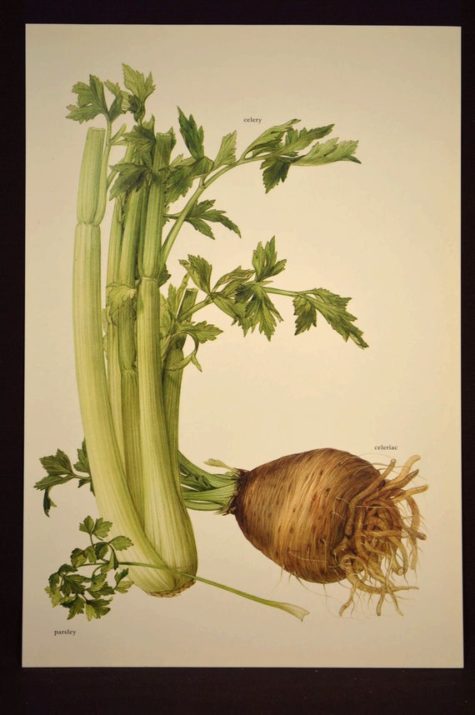
Folklore and History
Celery had its beginning several thousand years ago in shallow swampy areas of mainland China. The plant was prized for its seed, used medicinally and as a flavoring, and mentioned in the writings of Confucius. This would place it at about 500 B.C. on the world timeline.
A similar plant grew in the Mediterranean. It had a strong aroma (its Latin name means “strongly smelling”) and dark green leaves. The Greeks fashioned wreaths from it to adorn the victors in athletic and musical competitions. The Romans considered deemed it an aphrodisiac. And garlands of the leaves were found in Tutankhamun’s tomb.
The modern name “celery” comes from Greek selinon. It was ascribed to Silenus (or Seilenus), the son of a nymph and lustful Pan (or, according to other depictions, Hermes, the messenger of the gods who transgresses all borders).
Silenus, constantly drunk and lecherous, is depicted as pot-bellied with a beefy bald head and often with the ears, tail, and legs of a horse. He was the leader of the lustful horde of satyrs as well as the teacher and companion of Dionysus, the god of inebriation. Half human, half horse, Dionysus symbolizes, among other things, the powerful animal drive. The association of this satyr with celery, emphasizes the plant’s use as an effective agent of sexual potency.
Celery is presented as signifying both death and sensual pleasures in Homer’s epic The Odyssey: celery grows among violets in the meadows on Calypso’s magical island. (The Hellenes classified violets as “erotic plants,” which they dedicated to Priapus, the little deity with the big phallus; Aphrodite, the goddess of love; and Persephone, the goddess of the underworld and the dead.)
In the Odyssey, the enchantress Calypso took in shipwrecked Odysseus and held him enraptured for seven years; she also turned his men into “swine.” Comparative religion studies indicate that Calypso was a goddess of death, as the name suggests (kalypto = to enshroud) and that pigs were sacred to the earth and death goddess of antiquity.
That Odysseus ultimately freed himself from her magic is seen as a victory over death, as in all mythologies the hero, having come dangerously close to death, succeeds in wresting new life from the dark forces. This interpretation lends meaning to the ancient Greek practice of crowning winners of riding and gymnastic games with celery leaves.
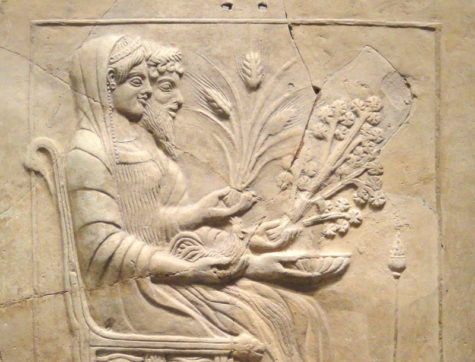
Celery has a long association with death. Ancient Egyptian mummies were often decorated with celery and blue lotus blossoms. Ancient Greeks planted it on graves and used it to season funeral feasts. The Roman Virgil (70–19 BC) described much the same:
“Godly Linus decorated his head with flowers and bitter celery [as a sign of mourning]”
“It is not right to put celery in common dishes because it belongs to funeral feasts.”
The Romans also dedicated celery, as part of the death rites, to Orcus, the god of the underworld, as told by Plutarch (45–120 AD): “We decorate our gravesites with celery.” Given such practices, it was considered a bad omen to see a cart loaded with celery first thing in the morning. And for someone who was marked by death, the Romans said: “There is only celery left for him.” This is an interesting angle given the fact that, like the ancient Greeks, Romans also crowned their victors with celery leaves. And celery, next to dill and coriander, was a favorite condiment in the Roman cuisine.
Celery’s association with death lasted well into our own times. Wend (Slavic) tradition in northern German Spreewald claims that merek (celery) protects against being haunted by the dead.
And the Italian fairy tale “Marianne and the Celery King” tells of a maiden who, attempting to pull a celery bulb from the soil is instead pulled into the ground; “the ground closed over them like water over a stone.” Below the earth, she finds a golden castle and an old, long-bearded hunchbacked man who resembles a celery root: the Celery King, who marries and impregnates her. But he is also an enchanted prince. After the heroine surmounts numerous tasks and challenges she is able to redeem the prince and bring him back to the world above the ground.
Nowadays such stories are given anecdotic value at most. However, traditional customs, folklore, and imaginative perception teach us much about the essence of the plant. In such imaginative terms, let us consider the celery.
Celery is a biennial; its “incarnation” lasts two years. In the first year, it concentrates on absorbing salty, moist earth forces, during which time it swells and becomes lush. During this year there is a clear pull to the dark, cool earth realm, to downward-moving elements and, figuratively speaking, to the grave, bitter death, and the mourning that causes salty tears to flow—but also to the fertile, ever-bearing primal source.
In the second year the plant ascends to the light, shooting up into bloom, opening and branching out as it bathes in cosmic light. The plant now sets a counterpoint to the earthy, moist, salty forces with its “light and fiery” essential oils.
Thus it becomes a plant for victors and heroes, one that overcomes the dark forces, that wards off the evil eye (in Spain), that thwarts the scheming of wicked witches. Even in modern Greece celery blossoms—together with garlic and onion—are hung for good luck. They protect the area where silk worms are being raised; small children are given amulets of celery to keep them from harm.
In Prussia and Pomerania the leaves were stuffed into cracks in floors and walls in pigsties to protect the animals from evil magic—and young married couples were given a piece of root to put in a pocket or a shoe for good luck.
Nicholas Culpeper (1616–1654) recognized the ambivalent nature of celery. He ascribed the plant to the hermaphroditic god, Mercury—the Roman Hermes, who can as easily fly up to the light-filled world of the gods as he can descend to the underworld. Indeed, Mercury-Hermes is the ruler of rising and sinking energy flow. He loosens, cleanses, opens, splits, and removes blockages by bringing everything back into flow.
Culpeper, just as other doctors before and after him, used this mercurial plant to heal “water diseases,” “obstructions” while urinating, and stone ailments, and to activate the liver and the spleen.
Celery works in the microcosm of the human body true to character. It affects the root chakra, the Muladhara, down into the sexual organs and the “salty, watery” urinary organs. Celery can reduce the milk flow for nursing mothers—a compress can actually temporarily reduce the breast size—but can also stimulate the uterus and bring on menstruation.
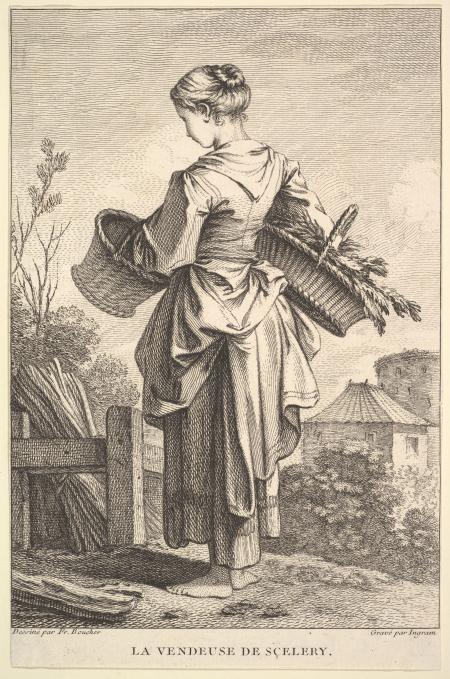
As “maiden’s smallage” it belonged to the herbs that women took in case of a “belated period,” when they feared they’d been impregnated. German scholar and bishop Albertus Magnus (1200–1280) described the downward pull of the plant: “Celery causes sensual desire to descend from the breasts of wet nurses to the genital area and bring about menstruation.”
It is often the case that emmenagogues work for men as aphrodisiacs, as indicated in such names as “stand-up herb” (Lausitz, Germany), “stand-up wort,” “stud wort” and “buck’s wort.” A fifteenth-century medical book tells us: “So that your wife stays faithful forever mix celery juice and honey and rub your genitals with the mixture. This way she will be satisfied and will want no one else but you.” Consider too this German saying:
Fry me eggs, sweetheart,
with celery and lettuce,
on Sunday we will go courting,
my mother told me this.
This aspect of celery is also well known in France, the country of savoir vivre and l’amour, as in the following: “If a woman knew what celery does to a man, she would be willing to go from Paris to Rome to find it.” And, “If a man knew what celery does for him, he would plant his garden full of it.”
In 14th-century Italy where the rich and curious began to selectively cultivate celery. The stalks became fatter and pleasingly crunchy; they paled from intense dark green to a subtle, delicate hue; and the taste evolved from bitter to pleasingly grassy and citrus-like.
When celery lost its flavorful wild side, it also became less rampant. These new strains were fussy and difficult to obtain, which of course made them irresistible to the elite. By the mid-19th century, celery was so prized by the upper class that serving vases were made specifically for the purpose of displaying it as the centerpiece at fine dinners.
While European epicures were feasting on blanched celery au velouté, American farmers were reveling in how easy it was to cultivate the luxury vegetable in the Great Lakes region. They were resourceful, ambitious, and even competitive when it came to growing celery.
As the celery craze was reaching its zenith in the 1870s, Dutch farmers who knew how to handle wetlands began growing the vegetable in the black, marshy soils of Kalamazoo, Michigan, which became known by the catchy name the Celery City. The streets were littered with hucksters peddling celery from street corners and train stations. As American cultivation improved, celery became an everyman’s item. By then, the British upper classes had moved on to French luxuries like truffles and oysters.
Sources:
- Magickal Aromatherapy by Scott Cunningham
- Publicism
- Encyclopedia of Magickal Ingredients
- Encyclopedia of Herbology
Here is a list of the five useful colors for negative work. These can be used for candles, mojo bags, etc.
- Red: Hotfoot, Speed, Anger, Violence
- Black: General Curses, Death, Bad Luck
- Purple: Domination, Loss of Power, Addiction
- Yellow: Legal Troubles, Lose Favor, Illness in the Belly
- Green: Sickness, Loss of Money, Rot and Decay
Note: Curses, hexes, jinxes, and other negative spell work should not be undertaken lightly, and are not recommended as they have a tendency to blow back on the person casting the spell.
Source: Hoodoo Delish
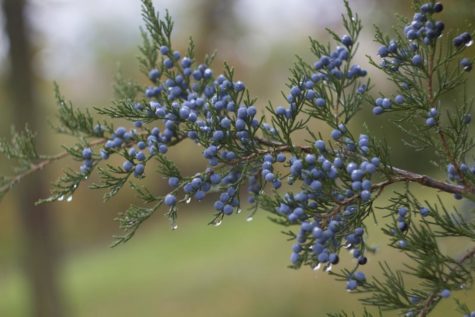
- Ruler: Sun
- Magickal form: Incense, fresh sprigs, berries, essential oil
- Basic Powers: Protection, Love, Healing, Cleansing
- Cautions: Do not drink the tea if you are pregnant, wish to become pregnant, or if you have kidney disease.
In the past, Juniper was regarded as a magick shrub to use against devils, evil spirits, and wild animals. It is mentioned in the Bible as a symbol of protection. Its aromatic scent made it a popular strewing herb, and shoots were burned to disinfect the air in a room.
Brew the berries into a tea and drink it to increase sexual stamina. Crush dried berries to release their scent and add to love potions to attract a man. String the matured berries for an attractive charm designed to attract lovers.
Juniper berries can be used in love spells, particularly to enhance male interest and potency. Steep in wine and drink a few sips daily to increase male virility. Steep in vinegar and add it to your bath to make yourself more attractive to men or apply it directly to the genitals (diluted with water) to increase male interest in them. Or add it to a bath you’re sharing. Juniper berries and their essential oils make for a nice “masculine” scent for men’s cosmetics (aftershave, beard oil, etc.). Use with due caution.
Hang a sprig of fresh Juniper in the home to drive away evil. A sprig of Juniper will protect the wearer from accidents. Sometimes used in anti-theft sachets, as it guards against thieves. Grow Juniper at your doorstep for protection. Gin (which is made from Juniper) can be sprinkled across a threshold to guard against theft.
Juniper is a thief catcher. If you bend a young Juniper branch down to the ground and hold it where you place it with two weights, one a big stone, the other the skull of a murderer, and say, “Juniper, I bend and squeeze you till the thief (name him) returns what he has taken to its place,” the culprit will feel an unaccountable impulse to return the property.’
Brush down the body with a bundle of sprigs to remove illness and place drops of oil in a bowl of water to promote healing in a sick room. Burn Juniper for purification and good health. One of the earliest incenses used by Witches was made from a combination of the leaves and the dried crushed berries.
Though burning Juniper wood gives off only minimal visible smoke, this smoke is highly aromatic, and in ancient times it was used for the ritual purification of temples. The smoke was said to aid clairvoyance, and continued to be burned for purification and to stimulate contact with the Otherworld at the autumn Samhain fire festival at the beginning of the Celtic year.
In central Europe Juniper smoke played a part in the spring-time cleansing and casting out of witchcraft. Juniper was also burned during outbreaks of the Plague, and in Scotland the disease could be dispelled by fumigating the house with Juniper smoke while its occupants were inside, after which the house was aired and the occupants revived with whisky!
Juniper was burned to goddesses and gods in ancient Sumer and Babylon, and was widely used in Egyptian incense formulas. It was sacred to Inanna and her later counterpart Ishtar. Many centuries later in Europe, branches of Juniper were smoldered and carried around fields and farms to release protective energies and guard livestock and crops.
It is a common ritual incense ingredient in Tibet and was much used by various Native American groups.
It is said that a Juniper shrub or tree is a particularly effective and magical hiding place. Perhaps Juniper can be added to hiding and invisibility charms as well.
Juniper essential oil is currently used in traditional aromatherapy to detoxify the body, as a parasite destroyer and antiseptic. This seems in keeping with the “magickal” use of purifying homes and fields mentioned above, for protective rituals are designed to ward off negativity as well as to purge such energies from a person or place.
Inhale Juniper essential oil while visualizing its energies guarding you from negativity and danger. Or, for an internal purification, smell Juniper and visualize.
You can also make Juniper a part of health-maintaining rituals. Regularly smell the scent while seeing yourself eating correctly, exercising, and thinking positively.
Notes:
Because it is a variety of Juniper, and the magickal uses are quite similar, Eastern Red Cedar can be used as a substitute, and vice versa. More about Red Cedar can be found here.
A Healing Ritual
There was a folk medicine custom in some parts of the South West of England of burning the wood and needles close to a sick person. This practice is closely allied to the above New Year customs and presumably recognizes that the vaporized oil released into the air had some beneficial purifying effect to dispel infection.
Like many plants, there was a definite ritual which had to be followed when pulling or collecting Juniper so that the power and essence of the plant was not lost. In the case of Juniper, it had to be pulled up by the roots, the branches made into four bundles and held between the five fingers while intoning the appropriate incantation. Unfortunately the version which has been passed down to us has been heavily Christianised:
“I will pull the bounteous yew,
Through the five bent ribs of Christ,
In the name of the Father, the Son and the Holy Ghost
Against drowning, danger and confusion.”

Juniper Mythology and Lore
Juniper was a symbol of the Canaanites’ fertility goddess Ashera or Astarte in Syria. In the Bible’s Old Testament, a Juniper with an angelic presence sheltered the prophet Elijah from Queen Jezebel’s pursuit. Similarly a later apocryphal biblical tale tells of how the infant Jesus and his parents were hidden from King Herod’s soldiers by a Juniper during their flight into Egypt.
Juniper plants are associated with protection in many different Native American tribes. The Interior Salish and Northwest Coast tribes used Juniper to banish evil spirits and protect themselves from witchcraft.
Among the southwestern Pueblos, junipers were believed to counteract ‘ghost sickness,’ a malady which afflicted bereaved relatives or people who handle the bodies of the dead.
Plains Indian tribes, such as the Dakota, Cheyenne, and Pawnee, often hung Juniper boughs on their tepees or burned them in the camp fire to keep their homes safe from storms.
And in many tribes people, especially hunters, would carry a spring of Juniper as a protective charm or rub Juniper branches on their bodies before embarking on a dangerous journey to protect themselves from grizzly bears, monsters, or general bad luck.
Juniper is one of the herbs frequently included in medicine bundles and amulets. Juniper berries were also eaten by people in some Southwestern and Southern California tribes, and Juniper leaves were frequently used as medicinal herbs.
Folk tradition records a divinatory significance to the appearance of Juniper in dreams, for:
- It is unlucky to dream of the tree itself, especially if the person is sick.
- To dream of gathering the berries, if it be in winter, denotes prosperity.
- To dream of the actual berries signifies that the dreamer will shortly arrive at great honors and become an important person.
- To the married it foretells the birth of a male child.
The largest body of folklore concerning Juniper comes from Iceland where it was traditionally believed that Juniper and rowan could not grow together because each creates so much heat that one or other of the trees would be burn up. For the same reason it was considered not a good idea to bring sprigs of both woods into the house together unless you particularly wanted your house to burn down.
Another Icelandic belief has it that if you are building a boat, you must either use both Juniper and rowan wood or use neither of them in the boat, otherwise it will sink.
In Wales it was said that anyone who cut down a Juniper tree would be dead within a year, while in Newfoundland it was believed that wolves and bears are repelled by Juniper wood and for this reason people who kept stock would ensure that Juniper wood was used in building enclosures or stockades in which livestock would be kept.
Also in Newfoundland it is believed that you will always find water under a Juniper tree, though this seems to contradict the natural history of Juniper which, as mentioned above, generally grows best on limestone or chalk soils which are usually well-drained.
The Story entitled Red Riding Hood in the book The Hero of Esthonia tells of a mother laying down Juniper branches and making the sign of the cross over them to protect her sleeping children from devils. In the story The Compassionate Shoemaker in the same book, the devil is defeated by being struck by a staff of Juniper.
In the Argonautica, Medea uses a freshly cut spray of Juniper to sprinkle her sleeping potion into the eyes of the serpent guarding the Golden Fleece.
- Meaning and history of the name Juniper:
From the Latin, juniperus which means “youth producing” or “evergreen.” During the Renaissance era, Junipers were used symbolically in art to represent chastity. Juniper has historically been used as both a boys and girls name, in fact Saint Juniper and Thornton Wilder’s character Brother Juniper are both male.

The Juniper Tree – A Story
“The Juniper Tree” is a German fairy tale collected by the Brothers Grimm. The text in the Grimm collection is in Low German and was originally written down by the painter Philipp Otto Runge. The complete story as originally written can be found over at Widdershins.
Here is a synopsis:
A wealthy and pious couple pray every day for God to grant them a child. One winter, under the Juniper tree in the courtyard, the wife peels an apple. She cuts her finger and drops of blood fall onto the snow. This leads her to wish for a child to be as white as snow and as red as blood. Six months later, the wife becomes gravely ill from eating Juniper berries and asks her husband to bury her beneath the Juniper tree if she dies.
A month later, she gives birth to a baby boy as white as snow and as red as blood. She dies of happiness. Keeping his promise, the husband buries her beneath the Juniper tree. He eventually marries again and he and his new wife have a daughter named Marlinchen (in some versions Marlene, Marjory or Ann Marie).
The new wife loves Marlinchen but despises her stepson. She abuses him every day, claiming that she wishes Marlinchen to inherit her father’s wealth instead of her stepson. One afternoon after school, the stepmother plans to lure her stepson into an empty room containing a chest of apples. Marlinchen sees the chest and asks for an apple, which the stepmother gracefully offers. However, when the boy enters the room and reaches down the chest for an apple, the stepmother slams the lid onto his neck, decapitating him.
The stepmother binds his head with the rest of his body with a bandage and props his body onto a chair outside, with an apple on his lap. Marlinchen, unaware of the situation, asks her stepbrother for an apple. Hearing no response, she is forced by her mother to box him in the ear, causing his head to roll onto the ground.
Marlinchen profusely cries throughout the day whilst the stepmother dismembers the stepson’s body and cooks him into a “blood-soup” for dinner. She later deceives her husband by telling him that his son stayed at the mother’s great uncle’s house. The husband unwittingly eats the “blood-soup” during dinner and proclaims it to be delicious. Marlinchen gathers the bones from the dinner and buries them beneath the Juniper tree with a handkerchief.
Suddenly, a mist emerges from the Juniper tree and a beautiful bird flies out. The bird visits the local townspeople and sings about its brutal murder at the hands of its stepmother. Captivated by its lullaby, a goldsmith, a shoemaker and a miller offer the bird a gold chain, a pair of red shoes and a millstone in return for the bird singing its song again. The bird returns home to give the gold chain to the husband while giving Marlinchen the red shoes.
Meanwhile, the stepmother complains about the “raging fires within her arteries”, revealed to be the real cause of her anger and hatred towards her stepson. She goes outside for relief but the bird drops the millstone onto her head, killing her instantly. Surrounded by smoke and flames, the son, revealed to be the bird, emerges and reunites with his family. They celebrate and head inside for lunch, and live happily ever after.
Sources:
- Encyclopedia of Herbology
- Plant Lore
- Trees For Life
- Witchipedia
- White Dragon
- Encyclopedia of Magickal Ingredients
- The Herb Stop Blog
- Magical Herbalism by Scott Cunningham
- Magical Aromatherapy by Scott Cunningham

- Latin Name: Thuja occidentalis
- Alternative names: Thuja, White Cedar
- Ruler: Sun, Venus
- Type: Evergreen Tree
- Magickal Form: Bark chips, Twigs and Branch tips, Essential Oil
One of the holiest of woods, cedar is considered feminine and receptive in nature. White Cedar (Arborvitae) denotes great beauty, majesty, and strength. It is highly protective when worn and draws money, good health, and well-being when burned. White Cedar (Arborvitae) wood and bark appear in spells where benevolent power is needed.
Add to love potions when strength is needed to overcome hardships. White Cedar (Arborvitae) opens up intuitive channels and brings forth compassion and humility. It is a true symbol of prosperity.
To move a person out without hurting him, cut three White Cedar branches, one three feet long and the others one foot long. Carry them to the person’s house and lay the long branch on the pathway, touching the front door and pointing to the street. Place the two short branches crosswise to this, at equal distances from each other to make a “double cross” shape. As you lay down the branches say: Now you will move by Faith (first branch). Hope (second branch). and Charity (third branch). Then walk away.
To rent a room put Arborvitae or White Cedar oil on the doorknob. People who come to see the room, will touch the doorknob and they will be more inclined to rent it.
To make the one you love follow you, wrap a fresh fig leaf tightly around a strip of White Cedar bark and wrap a leaf torn fro the Bible tightly around them both. Carry this on you, and your lover will follow you if you move.
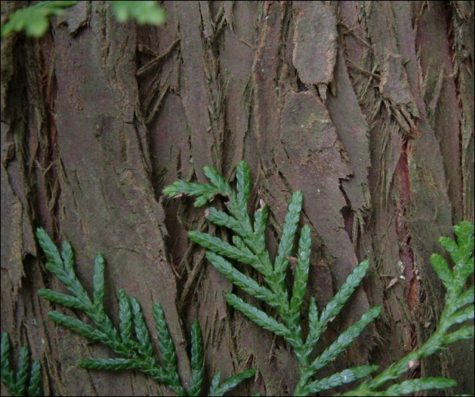
History and Lore
White Cedar (Arborvitae) is a tree with important uses in traditional Ojibwe culture. Honored with the name Nookomis Giizhik (“Grandmother Cedar”), the tree is the subject of sacred legends and is considered a gift to humanity for its myriad uses, among them crafts, construction, and medicine.
A nice native American story about the Cedar can be found here: The Story Of Cedar.
It is one of the four plants of the Ojibwe medicine wheel, associated with the north. White-cedar foliage is rich in Vitamin C and is believed to be the annedda which cured the scurvy of Jacques Cartier and his party in the winter of 1535–1536. There are some reports that the Ojibwa made a soup from the inner bark of the soft twigs.

Arborvitae Aromatherapy
Turn Arborvitae oil into a household spray with this easy do-it-yourself. Add a few drops of Arborvitae essential oil into a spray bottle and add water. Use this spray on surfaces or on hands. Arborvitae oil is a powerful cleansing and purifying agent. By incorporating this spray into your home, you can protect yourself and your family against seasonal and environmental threats while keeping your house fresh and clean.
Arborvitae essential oil has the ability to inspire feelings of peace and calm. If you are looking for a great way to unwind after a long day, place a few drops of Arborvitae oil into a diffuser or rub a drop of Arborvitae oil onto your wrists to produce a sense of peace and calm. Additionally, using Arborvitae essential oil during yoga or Pilates can increase the effectivity of your experience by inducing feelings of soothing relaxation. Diffusing Arborvitae essential oil can also help purify the air and provide a grounding aroma.
Bring your furniture back to life with this DIY Wood Polish with essential oils. If you want to keep wood looking fresh and clean, it is important to invest in proper cleaning supplies and a good routine. One of the most effective ways to clean wood is by using a wood polish that is natural and free of any harmful chemicals. Many commercial wood polishes contain chemicals and artificial fragrances that can cause irritation or health problems when not applied with proper safety precautions. Follow the instructions to this homemade solution to create a natural wood polish that is free of harmful toxins.
Wood furniture should only be polished every couple of months, but make sure to maintain the look and quality of your wood furniture by frequently dusting it or wiping it with a damp microfiber cloth. This will help to keep dust and damaging substances away from the wood and will help keep the wood from looking aged.
Create your own musky outdoor cologne with Arborvitae essential oil. Arborvitae oil’s aroma is woody and warm and when combined with Cedarwood and Frankincense, provides an invigorating aroma, perfect for a fresh cologne scent. Using these oils together will create a great cologne for any occasion and will also produce a fragrance that uplifts and relaxes the senses.
Arborvitae essential oil blends well with Birch, Cedarwood, Cassia, Cinnamon Bark, and Eucalyptus essential oils for diffusion.
Sources:
- Encyclopedia of Herbology
- Encyclopedia of Magickal Ingredients
- Hoodoo Herb and Root Magick
- doTERRA
- Latin Name: Juniperus virginiana
- Planet: Sun
- Element: Fire
- Part Used: Dried wood, essential oil
- Magickal Influences: Spirituality, Self-control
- Warning: Cedarwood oil should not be used by pregnant women.
Cedar has an important place in many cultures as a strong spiritual agent with a cleansing presence, a protective plant in rituals and as medicine. It is commonly ascribed similar properties as Sage; the needles, bark, or sap is burnt as an incense, the smoke it emits protecting and cleansing against spiritual “residue.” Cedar can be “smudged” like sage, to purify a space, home, or person.
In the ancient world, cedar from Lebanon was highly prized – so much so that only a few trees remain standing in that country. The name Lebanon is derived from the Akkadian word lubbunu, incense.
This was one of the most widely used incenses in the general Mesopotamian region and by the pre-contact Native American tribes.
There are few among us who aren’t familiar with the rich scent of cedar. Shavings of the wood are sold in pet supply stores. The characteristic smell of pencils stems from the red cedarwood used to produce them. And many of us have at least smelled a cedarwood chest. These are ideal for storing magickal supplies (everything, that is, except herbs and essential oils).
The fragrant, calming smoke when the wood burns is believed to allay nightmares, night terrors, hauntings, malevolent influences/thought forms, evil spirits, and ill-meaning wild animals. Many native peoples in North America use the smoke to cleanse a home; in the Native-Hispanic traditions, home-cleansings are called “limpias,” and Cedar wood being favored in this way. Again, the smoke of Cedar is used to purify the body, not just the home.
Two main cedarwood essential oils are available. Because the essential oils share similar constituents, Atlas Cedarwood (Cedrus atlantica) or Red Cedarwood (Juniperus virginiana) can be used with equal effectiveness in magickal aromatherapy.
The scent of the wood and the essential oil promotes spirituality. Inhale this sweetly antiseptic, calming fragrance before religious rituals to deepen your connection with Deity.
It’s spiritual qualities make the fragrance of cedar ideal for bringing ourselves into balance. Smell the aroma and visualize yourself as poised, calm, and in control of your own life.
Many Cherokee descendants carry a small piece of cedar wood in their medicine bags worn around the neck for protection. In a legend of the cedar tree told by the Cherokee Indians, the trees literally hold spirits of their ancestors, and they believe the wood carries powerful protective spirits. It is told that the Creator placed the spirits of their people in a newly created tree which makes it a very special tree indeed.
In another old Indian legend, a young hunter has a vision of a redheaded woodpecker that teaches him how to make the flute from a red cedarwood tree; the young hunter uses his flute as a love charm to win his wife, who was the daughter of a big and powerful chief of the village.
It made its way into folklore; bringing good luck and good fortune, health and healing, cedar was burned to invite positive energy, happiness, harmony and peace. Cedar chips or shavings were burned to purify the vibrations of your sacred area and house, driving out all negative entities. Fresh cedar boughs are used as brooms for purification, exorcisms and to cleanse temples.

Superstitions and Lore
The Eastern Red Cedar is a slow growing tree and lives to be very old. It gets its name, grave yard tree, because of an old superstition that says, when a red cedar you planted grows tall enough to shade your grave, it will be time for you to die.
Never transplant a Cedar tree, it is bad luck. If you do transplant a Cedar tree and it dies, you will die soon thereafter.
In the Medieval Christian tradition, a cedar trees (along with elder trees) were thought to possibly have been used to make the cross that Jesus was crucified on, for this reason it was considered bad luck to burn cedar. It was also believed that Cedar brought poverty, so it was not a good idea to put one in your yard.
On the other hand, if a Cedar tree comes up on your land, don’t cut it down. As long as that tree flourishes, your family will have good health.
The Arabs referred to the older Cedars of Lebanon as “saints” and believed that he who injured one would be overtaken by evil.

Some Thoughts About Red Cedar
From the Iowa Herbalist here are some interesting thoughts about the Eastern Red Cedar:
I always find it interesting and thought-provoking when the spiritual and emotional effects of plants reflect their physical ones. Just as Cedar seeks to purge our bodies of spiritual impurities, or to protect a home from negative influences, the hard reality is seen at work when Cedar is taken as medicine: whether it is expelling mucus from our lungs as a stimulating expectorant, clearing them of bacterial or viral infection; or opening up our pores in a cleansing fever to clear toxins, as invoked and adopted by sweat ceremonies. Whether you believe in esoteric herbalism, or not, Cedar does one thing: it cleans us, in mind and body.
Now, when I take that mind-transporting whiff of Cedar smoke, I realize why I felt that way. This beautiful tree’s magic is powerful. If you ever need a friend in the midst of illness, or during a hard emotional time, or if you just need to get some bugs out of your system– Cedar is your herb.
If you wish for simpler times, are feeling nostalgic or just want to reminisce, no plant can summon that feeling better; taking you far up into a cabin in the mountains, surrounded by pines and firs, and blankets. Enjoy it in a tea, your favorite elixir, a tasty syrup or perhaps in a calming incense blend. I remember such effects when I’m winding in between the rust-colored Eastern Red Cedars, peppered across Iowa’s tawny grasslands in winter, harvesting their little blue cones. Each time I bring in a jar or two, I spread some of the berries in places where Cedars don’t grow– to make sure there are more trees there for us to enjoy in the future. It’s my way of saying: “Thank you.”
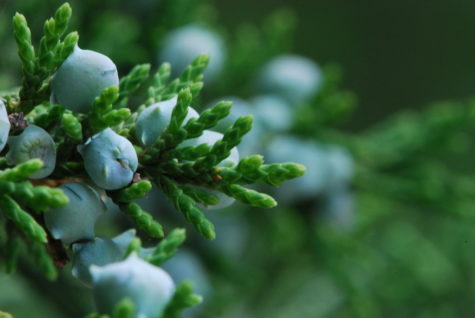
About Juniper
Because Red Cedar is a Juniper plant, the following also holds true.
Juniper, particularly through her wood and berries, is an absolutely wonderful tree with a wide range of uses. In terms of overall meanings in a North American context, we might summarize with the following:
Juniper is about warmth and fire. Juniper helps warm people up and is a strong fire-dominant tree, suggesting many associations with fire: passion, energy, warmth, and the sun.
Juniper offers hope in dark times. Juniper’s berries have long been a staple through the darkest of winters, and I see this both physically and metaphorically. Culturally, we are in a period of darkness, and trees like Juniper can help see us through.
Juniper offers regeneration and bringing things back. Juniper’s ability to grow in places few other trees can demonstrate that this tree is a true land healer, offering us hope in these dark times and sharing the critical message of the healing power of nature. I also think this is tied to its sympathetic magick uses in the American magickal traditions–Juniper helps bring things back.
Sources:
- Encyclopedia of Herbology
- Locusts and Honey
- Magical Aromatherapy by Scott Cunningham
- Iowa Herbalist
- Encyclopedia of Superstitions
- Druid’s Garden
Folk Names:
- Angel Food
- Archangel
- Garden Angelica
- Masterwort
- Root of the Holy Ghost
Magickal Uses:
Angelica (Angelica archangelica) is known in magickal herbalism as a powerful guardian and healer. It is said to banish negativity and attract positive energy. Angelica grows in tall, blossoming stalks—but typically only the root portion is used in spellwork. It is said to enhance female power, protect children, ward off evil, and improve health and family matters.
Angelica means angelic and in the places where it grows, it has been revered as a special plant. In Scandanavia, it was used as a shamanic medicine by the indigenous Sami people. In the U.S., various varieties of Angelica were used in rituals and ceremonies by Native American tribes. The Iroquois brewed Angelica root into a tea and sprinkled it about their homes to quiet “rattling” ghosts.
Angelica’s magickal virtues are linked to its robust stature, pleasant aroma, and association with the Archangel Michael. Legend has it that the angel appeared in a dream to a monk, showing him the herb that could cure the plague in Europe. Traditionally, Angelica blooms on the feast of the Apparition of the Archangel Michael, May 8.
Ruled by the Sun and associated with Venus, Angelica is most often used in spells for protection and exorcism. It can be grown in the garden as a protection. Carry the root with you as an amulet. Burn the dried leaves in exorcism rituals.
Burn the powdered root when you want to invoke angels. Because Angelica is a healing herb, you can mix it in bathwater to promote good health. it also removes hexes. Sprinkle around the house to ward off evil or dry dust your body to remove a curse. It is an ingredient in a Hoodoo working known as the Fiery Wall of Protection.
Angelica is also considered lucky, so rub the root between your palms when you gamble or pick your lottery numbers.
- Carry a piece of Angelica root to bring strength and ward off hexes.
- Put the root in a white mojo bag for protection, or a yellow one for courage.
- Add the dried root to incenses, floor washes, and baths to break jinxes and purify the home.
- Use Angelica to consecrate amulets of Archangel Michael and all Solar charms.
Angelica is associated with personal courage, when that courage is based in moral uprightness. Angelica is said to bring blessings of emotional temperance and harmonious home life.
Mexicans say that if a girl or young woman has been badly frightened, she should carry a whole Angelica root in a white bag. If she was frightened by a man, add a holy card of the Archangel Michael.
Folklore:
It is the date of the blooming that has been regarded as the source of the plant’s name. The day of Michael the Archangel used to be May 8, and Angelica blooms on that date, hence Angelica archangelica. There is more of Angelica in the folklore, such as the legend that an archangel revealed in a vision that Angelica would cure the plague. In time, Angelica came to be regarded as a simply angelic plant, and was known widely as “The Root of the Holy Ghost.”
The history of Angelica is rooted in prehistoric times and even the passage of centuries couldn’t shake the associations between Angelica and pagan beliefs from the Christian mind. It is altogether possible that the plant acquired its angelic stature in the folklore because of the pagan regard for the plant as an infallible guard against witches and evil spirits, and their spells and enchantments.
Peasants tied Angelica leaves around the necks of their children to protect them from harm, and even the name, when invoked, was supposed to be helpful in a jam.
It is alleged that it is the custom in the lake district of what was once Latvia for country peasants to take part in an annual procession, carrying Angelica stems to sell in the towns. Part of the procession is the chanting of a chorus with words so old that no one knows what they mean. This ritual was an early-summer custom and the words of the chorus have been passed from generation to generation.
Metaphysical Meanings
- Magnifies: Divine support, wisdom + deeper meaning
- Dissolves: Apathy, lack of connection, superficiality, surface level perspective
If you are attracted to Angelica, you may be interested in distilling a deeper meaning from everything in life. You may feel tired of things that feel flat or superficial, yearning for a deeper authentic connection to people and a truer intimacy in relationships.
Sometimes we feel safer staying on the surface level in our conversations and experiences. Other times we feel a sense of apathy, disengagement, or worry that there is no greater meaning to the occurrences in our lives. We may fight what happens to us, try to control it or feel hopeless vs. trusting in the wisdom of life.
Angelica magnifies our everyday experience of interconnectedness and deeper meaning woven throughout everything that happens in our lives. It enhances our awareness of benevolent unseen forces and angelic or protective support. It opens up a visceral sense of magic and synchronicity, and a feeling of being fortunate, lucky and grateful. Everything around us feels whimsical and rich with meaning.
We can relinquish control and allow ourselves to trust in the way life unfolds. We have a sense that we are connected to everything and that there is divine support in all our endeavors. We experience a knowingness that we are supported by divine or beneficial good forces and we can ask for assistance or have a relationship with them.
Sources:
This information was collected from a variety of sources all of which are listed in a much more in depth look at Angelica over at the Encyclopedia of Herbology
One of the strongest ingredients for male virility, the Horseradish root is in essence magickal Viagra. It is cultivated in the spring and difficult to find at any other time of the year.
- Women should lay the whole root on the belly and visualize either getting pregnant or being satisfied sexually.
- Men must hold the whole root to the genitals and visualize long-lasting erections.
- Perform these visualizations on a full moon.
Eat both white and red shredded horseradish at any time of the year for protection.
To reverse any malevolent magick against a building’s inhabitants, grate or grind dried horseradish root. Sprinkle it over your thresholds, corners, windows, and any areas perceived as vulnerable.
Source: Encyclopedia of Herbology
Also known as Creeping Charlie, Ground ivy has a strong connection with the powers of magick and divination. Folk names include:
- Alehoof
- Catsfoot
- Field balm
- Gill-by-the-ground
- Gill-over-the-ground
- Hay-maidens
- Hedge-maids
- Jenny-run-by-the-ground
- Lizzy-run-up-the-hedge
- Run-away-robin
- Tunhoof
Ground Ivy is bound to Saturn and water. It is used in magick mostly for divination purposes either by burning dried leaves, by using the oil to anoint a divinatory tool, such as a deck of Tarot cards or by drinking fresh or dried leaves in a tea.
Sachets, charms and teas made of fresh or dried ground ivy can be worn for help in rebuilding when you have given too much, as protection from theft, and for fidelity, honesty, and weddings or new love.
Considered a safeguard against sorcery it was worn by milkmaids when first milking cows in the pastures. A magic charm, it was used to prevent the cows from enchantment. In many regions the first milking of the cows was actually done through a wreath of ground ivy.
Other magical uses of ground ivy included promoting sleep, meditation, healing, love, friendship and fidelity. The ritual use of ground ivy was popular and the herb was often woven into crowns and garlands to be worn on Midsummer’s Eve.
Ground Ivy is very powerful in protection against evil magick and psychic attacks. Using this herb will help you in identifying other witches and will help you reveal who is using negative magick against you.
“To find out who might be using negative magic against you, place some ground ivy around the base of a yellow candle. Burn the candle on a Tuesday and the person will then become known to you.”
~Scott Cunningham
A tea of Gill-over-the-Ground may be sipped to help overcome shyness. Strewing leaves of this herb about the floors of your home is said to promote serenity and peaceful dreams.
If you celebrate Beltane, weave some stems and flowers into your crown. Pick an alias name for it that appeals to you—my personal favorite is Gill-over-the Ground. Repeat it several times until it rolls nicely off your tongue and sounds almost exotic. And, if you must pluck some of it, at least stop and pay homage to the myriad of uses of it throughout time. Ground ivy, a small herb with great determination!
Sources:
Animals are often archetypal symbols of sorts, and they also bring up certain images in people’s minds. Therefore, they are powerful symbols that can be used for a variety of purposes.
Animal likenesses can be used in the form of statues to guard the house; on jewelry to inspire or protect; in visions or manifested as spirit helpers for those that believe in totem animals; and even as a decoration whose meaning runs deeper than the surface. Little figurines of any animal can be included in a mojo bag or charm for symbolic value. Also, the behavior of an animal can be taken as a sign of things to come or events unknown.
Another interesting way to integrate the attributes of a specific animal, or to bring their power and presence into your life is to transfer the image of the animal to a very small piece of paper, roll the paper into a small ball and swallow it.
What follows is a by no means complete list of basic lore inspired by and expanded from The Magick of Folk Wisdom, and other sources. Use these symbols in combination with each other, with the symbolism of engraved stones, with color symbolism, and with anything else that is inspiring.
- Adder:
Transformation, Healing, Life Energy, Rebirth, Resurrection, Initiation, Wisdom, Cunning, Reincarnation
- Alligator, Crocodile:
Maternal Protection, Connection to the Earth Mother, Protection from Manipulation, Understanding Deceit, Revenge Through Patience, Initiation, Understanding Weather, Access to Ancient Knowledge, Aggression, Survival, Adaptability
- Ant:
Patience, Stamina, Planning, Energy, Communal Living, Storing for the Future, Group Minded, Perseverance, Step by Step, Teamwork, Industriousness, Order and Discipline. An ant bite signifies an upcoming fight. Use as a symbol for hard working and success.
- Ape and/or Monkey:
Put an ape on an amulet of protection. Use a monkey as a symbol of benevolence. Carrying an engraved monkey stone can lend levelheadedness. Envisioning apes on guard around you can help to be freed from unjust accusations.
- Badger:
Keeper of Stories, Bold Self-Expression, Aggressiveness, Single-Mindedness, Passion, Cunning, Revenge, Perseverance, Control, Antidote to Passivity or Victimization, Persistence in the Service of a Mission, Groundedness, Knowledge of the Earth, Earth Magick and Wisdom, Creative Action in a Crisis, Protection of Rights and Spiritual Ideas. Staying power and determination to overcome all odds. Carrying a badgers tooth – Good luck (especially for gamblers)
- Bat:
Death and Rebirth, Guardian of the Night, Cleaner. Often considered a sign of upcoming death or bad omen. Images of bats can aid eyesight. Use as a symbol of longevity and joy. Popular spirit guide because of night vision ability. Inspiring animal for meditation on enhancing psychic abilities.
The bat, which sometimes chooses a human as a companion or becomes a familiar to a human, is thought to confer long life, happiness and wealth to those humans with which it lives. The bat is sacred to Persephone, and thought to be lucky as a companion animal.
- Bear:
Introspection, Healing, Solitude, Change, Communication with Spirit, Death and Rebirth, Transformation, Astral Travel, Creature of Dreams, Shamans and Mystics, Visionaries, Defense and Revenge, Wisdom, Thoughtfulness, Need for Retreat, Rest, Natural Strength, Primal Power, Sovereignty, Intuitions Married with Instinct, Awakening the Power of the Unconscious, Introspection, Mother, Cunning, Healer, Dreaming, Direction, Connection to Creator, Nature’s Pharmacist.
An emblem of power and protection. Bear meat is said to be a cure for insomnia and baldness. A symbol of reborn springtime, after hibernation. Guardian of the West in some cultures. Honey bears symbolize truth. A bear appearing in real life or in dreams can symbolize a resting period followed by flourishing growth.
- Bee:
Connection to the Goddess Diana, Understanding Female Warrior Energy, Reincarnation, Communication with the Dead, Helping Earth-Bound Spirits Move on to Their Proper Place, Concentration, Prosperity, Community, Celebration, Organization, Fertility and the Honey of Life, Sweetness of Truth. Gods’ messengers. Carriers of good souls in the next life. A swarm of bees indicates a catastrophe on its way.
- Beaver:
Doer, Builder, Gatherer
- Birds:
The phrase “a little bird told me” harkens back to the time when birds were watched to divine the future. Ask a bird your question, then throw it some seed. If it eats it, the answer is ‘yes’; if it does not eat it, the answer is ‘no.’ A bird residing in your home as a companion animal will increase the memory and increase the mental powers of those with whom it connects. Birds are sacred to Mercury, their fallen feathers have many uses in spells.
Examples, of some bird feather practices include placing feathers above the doorway to prevent children from wandering out and getting lost, placing a wreath of feathers under a sick person’s pillow to speed recovery, and hanging feathers over a bed to prevent nightmares (note that feathers are also hung from dream catchers).
- Bison and Buffalo:
Popular totem animal of old. Buffalo image helps to inspire successful meditation. Earth Creativity, Feminine Courage, Abundance, Knowledge, Generosity, Hospitality, Sharing Work, Courage, Strength, Challenge, Survival, Giving for the Greater Good, Formulating Beneficial Plans, Prayer, Sacredness, Life Builder.
- Blackbird:
Enchantment, The Gateway, The Inner Call, Understanding of the Energies of Mother Nature
- Boar:
The Warrior Spirit, Leadership, Direction. Greek/Roman personification of victorious battle. A symbol of nature-based wealth. The boar is an inspiring symbol for success and protection, especially when the chips are down.
- Bobcat:
Clear Vision in Dark Places, Vigilance, Suspicion, Seeking Ancient Mystical Mysteries, Ability to Live in Solitude, Ability to See Through Masks
- Bull:
Wealth, Potency, Beneficence, Fertility
- Butterfly:
The three parts of the butterfly’s body symbolize the three phases of life. A good inspiration for transformation. A symbol of happy union when carved in jade. A group of butterflies indicates positive change on the way. Butterflies can carry the souls of the dead in some traditions.
- Cat:
Independence, Protection, Love, Allows us to Dream its Dreams, Assists in Meditation, Ability to Fight when Cornered, Mystery, Magic, Guardianship, Detachment, Sensuality, Aloofness, Balance, Wisdom, Recuperative Power, Reincarnation, Strong Protector, Self-Assured, Searching for Hidden Information, Seeing Spirits. Worshiped as divine in some cultures. Thought to have nine lives, so aligned with the symbolism of nine, a lucky number.
Black cats can be a bad omen for some, if they cross your path. The appearance of a stray cat at your door could indicate monetary gain. Asking a question and then watching a cat walk into the room was a divination procedure; if the cat stepped first into the room with the right paw, the answer was yes. A cat is popular for amulets used to keep the wearer safe in travel.
Of all animals, cats are most sacred to witches because of their connection to the Moon. Cats were sacred to Freya, Isis, Sekhmet, Astarte and Diana, among others. Sharing your home with cats brings many blessings and much luck.
- Chameleon:
Use of Color as Camouflage, Survival, Patience, Ability to Climb to Attain Ones Goals, Using the Sun as a Source of Power. A symbol of the ever-changing future, and of inconsistency. A resurrection symbol. Its appearance could be studied for signs of rain on the way. Useful inspiration for blending in.
The chameleon as a companion animal is believed to ward off the evil eye, increase sexual appetite, ward off disease and make humans more acceptable to other humans.
- Cheetah:
Ability to Focus Intently on Something for a Short Period of Time, Swiftness, Self-Esteem, Accelerating Time, Keenness of Sight, Speed, Making Events Occur Quicker
- Cobra:
Soul Guide, Memory of the Soul World, Transmutation of the Soul, Past Life Memories, Wisdom of the Goddess, Freedom from Religious Persecution
- Cougar:
Using Leadership Power Wisely and Without Ego, Balancing Power, Intention, Strength, Gaining Self-Confidence, Freedom from Guilt, Cunning, Savagery, Fury, Remorseless, Hunting, Seeking of Freedom, Balancing Intention, Power, Coming into Your Own Power, Courage, Swiftness, Balance
- Cow:
Being Alert to Danger, Contentment, Great Mother Goddess, Love, Connection to the Grasses, Sharing through Community, Vitality, Health, Prosperity, Life of the Land, Nourishment, Motherhood. One mother goddess symbol. Sacred in India. Red cows are a symbol of hope. Inspiring symbol for nurturing efforts.
- Coyote:
Understanding That All Things are Sacred–Yet Nothing is Sacred, Intelligence, Ability to Laugh at One’s Own Mistakes, Shape-Shifting, Teaching Balance Between Risk and Safety, Illumination, Stealth, Clowning and Humor, Wisdom of Folly, Prankster, Insight, Playful
- Crab:
Ability to Escape by Moving Sideways Understanding the Power of Dance, Ability to Move Through Water (Emotions), Male Aspects of Community, Protection of Home Space
- Cricket:
Some believe crickets are reincarnated family members come to bless the home. Good luck charm. If one lives in your chimney, you are blessed; if it leaves, bad things are on the way.
- Crow:
Guardian of the Place Before Existence, Carrier of Souls from Darkness into Light, Working Without Fear in Darkness, Guidance While Working in Shadow, Moves Freely in the Void, Understands all Things Related to Ethics, Shapeshifter, Secret Magic of Creation, Thief, Trickery, Boldness, Skill, Cunning, Single-Mindedness, A Bringer of Knowledge, Swiftness, Eloquence
- Deer:
Gentleness, Healing, Connection to the Earth and the Forest, Keen Scent, Grace, Swiftness, Being Alert for Any Danger, Psychic Powers, Innocence, Love, Kindness, Sensitivity, Pride, Independence, Purification, Strength, Nobility. Deerskin has been thought to help epileptic people be cured.
Visions or dreams of deer indicate desire to find the right path. Sighting a deer, especially if it is unafraid of you, is a sign of an influential person coming into your life to teach you what you most want to learn.
- Dog:
Guidance, Protection, Loyalty, Faithfulness, Devotion, Trust. A dog howling at the moon is a bad omen. Dogs can supposedly sense the presence of ghosts. If a dog hides under a table, a thunderstorm is on the way. Putting a coral necklace on your pet dog will protect it from disease. A dog arriving unexpectedly at your house forecasts the arrival of a new friendship. A dog’s appearance in a vision or dream indicates loyalty, service, and trust.
Dogs have long had a magickal place in religious rites. Dogs are sacred to Hecate and because of this, it is thought that dogs can see Hecate, or danger, approaching and warn humans. Thus, they are watchers of the home, and bring not only protection, but love.
- Dolphin:
Change, Wisdom, Balance, Harmony, Communication Skills, Freedom, Trust, Water Element Magick, Life, Breath, Communion with Nature, Protection, Psychic Awareness, Eloquence, Freedom, Magick, Discovery, Truth, Kindness, Play. Dolphins are thought to carry departed souls to the next incarnation. When dolphins leap often, a storm is coming. A dolphin image signifies joyous, childlike play and helpfulness.
- Donkey:
Placing an ailing person on a donkey’s back may bring them back from the brink of death. If the person cannot be placed to sit, passing them under the donkey’s belly three times does the trick. A donkey symbolizes fertility and easy childbirth. Donkeys are symbols of efficiency, health, well-being, and luck.
- Dove:
Peace, Love, Spirit messenger, Feminine Energies, Maternity, Prophesy
- Dragon:
Ancient Powers, Intelligence, Ferocity, Elemental Magick, Extra Power, Protection, Instruction in the Spiritual. A symbol of wisdom due to long lives and potent magick. Dragon charms can bring power. Visions or dreams of dragons can symbolize a person in power. Dreaming of flying on the back of a dragon symbolizes the beginning of a new spiritual insight.
- Dragonfly:
Dreams, Illusions, Understanding Dreams, Truth, Power of Light (Luminescence of Colors), Flighty, Carefree. Do not scare off a dragonfly; it brings harmony and serendipity. A symbol of dreams, luck, and ancient knowledge.
- Eagle, Golden Eagle, Sea Eagle:
Swiftness, Strength, Courage, Wisdom, Keen Sight, Illumination of Spirit, Healing, Creation, Knowledge of Magick, Ability to See Hidden Spiritual Truths, Connection to Spirit Guides and Teachers, Power, Intelligence, Renewal, Clear Vision, The Solar Bird, Spiritual Power, Carries Souls Back to the Dreamtime, Soul World Memory, Retrieves Lost Soul Parts.
- Elk:
Strength, Agility, Freedom, Power, Nobility
- Elephant:
Memory, Strength, Ancient Wisdom, Power
- Falcon:
Soul Healing, Accompanying the Soul Back to the Soul World, Teaching Swiftness, Controlling Speed and Movement, Understanding Magick, Astral Travelling, Healing
- Fish:
Associated with messiahs and saviors. Fish symbolize good luck and prosperity. Fish that dwell in wells are thought to be water spirits. Carp are symbolic of true love and courage, because of their upstream swim to spawning ground. Used as a symbol for foresight, fortune, and miracles.
Fish kept in the home offset negative energies because they are magically ruled by the Sun. Fish are also thought to attract money, ensure fertility and strengthen relationships, especially marriages.
- Fox:
Shapeshifting, Cleverness, Observational Skills, Cunning, Stealth, Camouflage, Feminine Courage, Invisibility, Ability to Observe Unseen, Persistence, Gentleness, Swiftness, Diplomacy, Wildness, Adaptation, Slyness, Wisdom, Protection, Provider, Intelligence. Foxes align themselves with certain families and appear to them when danger is near. Foxes can be seen as tricksters, Shapeshifters, and possessors of great magick. Visions or dreams of a fox may indicate a need to reevaluate your position.
- Frog and Toad:
Sensitivity, Medicine, Hidden Beauty and Power, Cleansing, Healing Magicks, Faith, Miracles. A frog’s tongue was used in the Middle Ages to place over a lover’s heart and make her answer truthfully. Frogs are thought to be able to take sickness away. Frogs symbolize health, honesty, and purification.
Frogs in the home bring good luck, increase fertility and cause new friends to visit the home. A frog in the garden brings rain. A frog also is a symbol of resurrection and renewal because it is ruled by Water.
- Gazelle:
If a gazelle crosses your path left to right, it is a bad omen. Thinking of the gazelle’s image in times when you need energy can help boost your personal power. Gazelles appearing in dreams indicate a need to settle an old score.
Goat: Sure Footedness, Seeking New Heights. Goats are aligned with Pan, and thus thought to be disguised forest deities. Goat’s fur or foot is an anti-evil talisman. Goat symbols can help to achieve goals, endure criticism, and stay safe.
- Goose:
Vigilance, Parenthood, Productive Power, The Call of the Quest, Travels to Legendary Places, Luck, Innocence, Story Telling, Fertility, Fidelity, Symbol of 8 and Infinity
- Hare:
Hares hopping into a churchyard are thought to be incarnations of departed young girls who died of abandonment. A hare crossing a pregnant woman’s path was unlucky. Hares are symbolic of lunar energy and fertility. If you see a hare unexpectedly, it can mean you may be dawdling on things that matter and should pick up the pace.
- Hawk:
Clear-Sightedness, Being Observant, Far-Memory, Messages from Spirit, Guardianship, Recalling Past Lives, Courage, Wisdom, Illumination, Seeing the Larger Picture, Creativity, Truth, Experience, Wise Use of Opportunities, Overcoming Problems, Nobility, Recollection, Cleansing, Visionary Power, Defense, New Life, Primal Life Force, Fulfillment, Messenger
- Hedgehog:
Hedgehogs are thought to be able to predict changes in the direction of the wind. Using an image of hedgehogs collecting grapes with their quills can help you reap the fruits of your labors.
- Hornet, Wasp, Yellowjacket:
Use of Female Warrior Energy, Sisterhood, Understanding Female Societies, Communal Living
- Horse:
The Goddess, the Land, Travel, Power, Freedom, Strength, Movement, Grace, Dignity, Stamina, Endurance, Faithfulness, Journey, Swiftness, Friends, Loyalty, Astral Traveling. Representative of transportation and communication. A black horse with a white marking on its forehead is lucky. Observing a white horse could give hints about the future.
- Hummingbird:
Messenger, Stopper of Time.
- Jaguar:
Seeing the Roads Within Chaos, Understanding the Patterns of Chaos, Moving Without Fear in the otherworld realms, Facilitating Soul Work, Empowering Oneself, Moving in Unknown Places, Shapeshifter, Psychic Sight, Releasing Fear. Some say shamans’ departed spirits can live on in jaguars. The jaguar is a good focus image for those wishing to begin a shaman path.
- Leopard, Snow Leopard:
Sensitivity to Touch, Stalking, Approaching Someone Unseen, Movement in Shadow Worlds, Communication with Plant Kingdom, Understanding One’s Shadow Side, Trusting One’s Inner Self, Agility, Strength
- Lion:
Letting Go of Stress, Strong Family Ties, Strength, Courage, Energy, Ferocity, Assertion of the Feminine and the Power of the Female Sun
- Lizard:
Detachment from Ego, Power to Regenerate That Which is Lost, Facing Fear, Controlling Dreams, Moving in the Otherworld, Conservation, Agility. Lizards, which are ruled by Mars, keep disease from the home.
- Lynx:
Keenness of Sight, Divination, Developing Psychic Senses, Keeper of all Secrets and Mysteries, Movement Through Time and Space, Secrets and Vision of the Hidden and Unseen
- Monkey:
Monkeys, ruled by Mercury, bring success, health and good fortune to the home.
- Moose:
Headstrong, Unstoppable Longevity.
- Mountain Lion:
Using Leadership Power Wisely and Without Ego, Balancing Power, Intention, Strength, Gaining Self-Confidence, Freedom from Guilt, Cunning
- Mouse:
Shyness, Quiet, Attention to Detail, Sneakiness
- Newt:
Newts, ruled by Saturn and sacred to Athena, bring intelligence and watchfulness to the home.
- Otter:
Joy, Playfulness, Sharing, Feminine Power, Helpfulness, Sharing, Adventure, the Magick of Joy, Youthful Exuberance, Zeal, Laughter, Curiosity, Mischievous.
- Owl:
Silent and Swift Movement, Seeing Behind Masks, Keen Sight, Messenger of Secrets and Omens, Shape-Shifting, Link Between the Dark, Unseen World and the World of Light, Comfort with Shadow Self, Moon Magick, Freedom, Silent Wisdom, Nocturnal Vision, Healing Powers, Magical, Detachment, Change, the Mystery of Magic, Omens, the Arts, Watchfulness, Night Magicks, Truth, Patience.
- Panther:
Astral Travel, Guardian Energy, Symbol of the Feminine, Understanding of Death, Reclaiming Ones Power, Ability to Know the Dark, Death, Rebirth, Swiftness, Cunning, Strength, Perseverance, Boldness, Beauty,. Gaining Confidence
- Parrot:
A parrot improves the wit of its human companions. Teaching a parrot lucky words with bring luck to you each time the parrot says the words. If a parrot whistles unexpectedly, rain is coming.
- Phoenix:
Overcoming Impossible Odds, Reincarnation, New Life/Cycles, Cleansing Energy of Fire, Rebirth, Renewal, Growth Spiritually, Strength, Energy
- Pig, Sow, Hog:
Crone Goddess, Rooting out the Truth, Deep Earth Magick, Past Life Knowledge, Intelligence, Cunning, Generosity, Nourishment, Discovery. Hogs are used as food for special occasions. Eating their meat is supposed to help the triumph over darkness. Pigs are symbolic of rebirth and rejuvenation.
- Rabbit, Hare:
Guile, Quick-Thinking, Humility, Strengthening Intuition, Releasing Fear, Overcoming the Past, Resolution to Change, Fertility, New Life, Alertness, Nurturing, Rebirth, Balance. Rabbit’s feet are lucky talismans, probably because of their swiftness.
Rabbits can be utilized in meditation by envisioning a rabbit hopping away and towing your troubles away from you. Saying “rabbit” as the last word before you sleep and “hare” as the first word when you wake up can bring a gift once a month. There are several variations on this.
- Raccoon:
Curiosity,Creativity, Dexterity, Disguise
- Raven:
Healing, Initiation, Protection, Magic, Shapeshifting, Creation, Help with Divination, Wisdom, Eloquence, Magick of the Crone, Trickster, Teacher, Hoarder.
- Salamander:
Connects Earth and Water, Connection to Soul Memories, Change, Comfort in Darkness, Ability to Cloak in the Face of Adversity
- Salmon:
Understanding Divination Messages, Rebirth of Spiritual Knowledge, Instinct, Persistence, Determination, Wisdom, Inspiration, Rejuvenation
- Scorpion:
Death, Rebirth, Transmutation, Repelling Negativity. When the sun is in the house of Scorpio, initiations can take place successfully, aligning the initiate with the fire sign. Scorpions symbolize the “fire within” that often needs careful tending.
- Seal:
Protection, Lucid dreaming, Creativity, Love, Longing, Dilemma, Active Imagination
- Shark:
Ability to Move Constantly, Remorselessness, Never Being Caught Off Guard, Ability to Defend Oneself, Hunter, Survival, Adaptability
- Sheep, Ram:
Confidence in Ones Abilities, Fertility, Courage, New beginnings, Abundance, Assurance in New Areas, Sacrifice, Breakthrough, Achievement
- Skunk:
Sensuality, Respect, Self Esteem, Shrewdness, Transformation, Life, Death, Rebirth, Rain, Fertility, Transmutation
- Snake:
Elusiveness, Transmutation, Exploration of the Mysteries of Life, Primitive or Elemental Energy, Protection from Religious Persecution, Goddess Energy, Psychic Energy, Creative Power, Immortality, Rebirth, Resurrection, Initiation, Wisdom, Healing, Transformation. Snakes are aligned with healing powers, and are sometimes kept as pets for that reason.
Snakes symbolize healing, fertility, and renewal and rebirth (because of its tendency to shed its skin). Tossing a dead snake into the air can divine rain; if it lands belly-up, here comes a storm. If an adder snake appears in the home, it is said that death will strike. Dreaming of a snake can be a warning that an acquaintance is working against you.
A snake brings wisdom and good health to its home companions. Snakes also bring longevity, wisdom and intelligence.
- Sphinx:
Initiation, End of a Cycle, Element Magick, Meeting the Dark Mother
- Spider:
Master Weaver, Weaver of the Web of Fate, Wisdom, Creativity, Divine Inspiration, Shapeshifting, Understanding the Patterns of Illusion, Female Energy for the Creative Force of Life, Creative, Connecting the Past with the Future, Creating Possibilities, Weaver of the Primordial Alphabet. It is unlucky to kill a spider. The spider’s weaving skills make it a good inspiration for any rituals involving networking and connection to the outside world.
Never kill a spider in the home; it will bring bad luck. Spiders kept as companions bring protection and increase intelligence. A spider’s web can be used to scry in the same way as a crystal ball for those who practice divination. To the Celts, the spider’s web symbolized the web that held all life together.
- Squirrel:
Conservation, Storage, Activity, Preparedness
- Swan:
Sensitive, Emotional, Dreamer, Mystic, Longevity, Awakening the True Beauty of the Power of the Self, Soul, Love, Beauty, Self-Transformation, Self-Images, Intuition, Empathy, Moon Magicks, Grace, Balance, Innocence
- Tarantula:
Ability to Shed the Outer Skin (Masks) and Transform, Creativity, Spinning a Web to Entrap Enemies, Defense of Territory, Intimidation by Size, Use of Environment to Conceal Oneself
- Tasmanian Devil:
Self-Defense, Protection of Territory, Ability to Use Perseverance When Necessary, Understanding of How and When to Fight
- Tiger:
Power, Energy, Strength and Will-Power in the Face of Adversity, Acting in a Timely Manner, Action Without Analysis, Passion, Devotion, Sensuality
- Toad:
Toads should not be kept in the house as they will react to psychics and to ghosts…unless, one wants to discern if there is a ghost present in the house. If there is a psychic person present, or a ghost present, a toad will act erratically. Toads found in the garden, however, bring intelligence to the gardener.
- Tortoise and Turtle:
Symbol of the Earth, Connection with the Center, Navigation Skills, Patience, Self-Boundaries, Associated with the Feminine, Power to Heal Female Diseases, Respecting the Boundaries of Others, Developing New Ideas, Self-Reliance, Tenacity, Nonviolent Defense, Motherhood, Linking Heaven to Earth, Awakening to Opportunities, Creative Source, Informed Decisions, Planning, Adaptability, Slow Progress, Retreat, Grounding, Chasity, Conservation, Mother Earth, Longevity.
A tortoise shell can be used in divination. Considered an inspiring symbol of the ocean gods. Turtles and tortoises symbolize persistence and wise choices.
Turtles are ruled by Venus and bring love, longevity and fertility. Patting a turtle on its shell with bring you good luck.
- Unicorn:
Spirit of Purity, Innocence, Childhood
- Whale:
Record Keeper for all Eternity, All Knowledge Associated with Voice, Psychic and Telepathic Abilities, All Aspects of the Sea, Beauty of Movement, Creation, Power of Song, Awakening Inner Depths, Ancient Knowledge, Sound Awareness. Some say whales have the power to cause earthquakes. Whales appearing in visions or dreams mean to concentrate on harnessing your own magick and aligning with the water element.
- Wolf:
Facing the End of One’s Cycle with Dignity and Courage, Death and Rebirth, Spirit Teaching, Instinct Linked with Intelligence, Social and Family Values, Outwitting Enemies, Steadfastness, Skill in Protection of Self and Family, Taking Advantage of Change, Intuition, Learning, the Shadow, Guardianship, Ritual, Loyalty, Spirit, a Pathfinder, Psychic Energy, Inner Divinity, Teaching, Careful Study, Cunning, Escaping Hunters, Ability to Pass by Dangers Invisibly
An Astral Wolf Could Lead You to a Spiritual Teacher, Strong Protection, Spiritual Guidance in Dreams and Meditations, the Teacher, Success, Perseverance, Stability, Thought
- Wolverine:
Revenge, Understanding Aggression, Protection Against Attackers, Multilevel Protection, Standing your Ground, Fierceness
- Wyvern:
Revenge, Retribution, Creating Protective Barriers of Fear as a Defense
The energies of solar flares and sun storms can be very effective when harnessed for magickal use. But what are they, and how do they affect us?
We seldom think of weather conditions as causing problems anywhere other than here on Earth. Inf act, we seldom even consider that there is any sort of weather anywhere else. But that’s just no so. Outer space has its own sort of weather, too, and Sun storms can definitely wreak havoc with it.
Sun storms are geomagnetic and caused by a series of eruptions and explosions on the Sun’s surface. These explosions emit lots of tiny particles that fly into space at speeds in excess of a thousand miles per hour, and set course for Earth’s atmosphere. And since they’re both radioactive and magnetized, they wreak havoc here, too, when they arrive.
So, what kinds of problems do they cause? Because they’re highly magnetized, they can screw up compass readings and interfere with global positioning systems. The latter, of course, is a real problem since most air traffic controllers use the GPS to track airplanes on radar.
They also have the ability to knock out power systems and cause blackouts, push satellites out of orbit, and interrupt radio transmissions.
And if that weren’t enough, this solar fallout also brings a hefty dose of radiation with its arrival; in fact, flying on a day when Sun storms are in progress often brings travelers ten times the radiation of a normal chest x-ray.
Be that as it may, though, the energies of these aggravating little storms can be very effective when harnessed for magickal use.
Because of the magnetized particles involved, they’re absolutely unsurpassed in power when it comes to attraction magick. In fact, nearly any magick worked during these periods comes to fruition quickly, provided that the desired result is visualized as being drawn to you like nails to a magnet.
Efforts to alleviate anger, stress, anxiety, and confusion ~ or anything else you’d like to eradicate from your life ~ also work well now. The trick is to visualize the problem breaking up into particles that fly away and dissolve into nothingness.
The good news is that Sun storms are predictable ~ but only by three or four days in advance. Still, that allows plenty of time for for practitioners to be ready to brag their power and use it to full advantage. If you are interested in utilizing this magick, here’s a link to Space Weather Live Solar Forecast.
Source: Everyday Sun Magic
